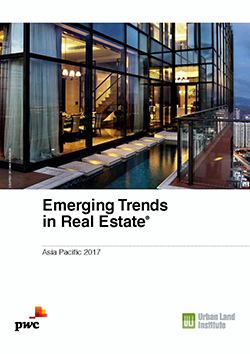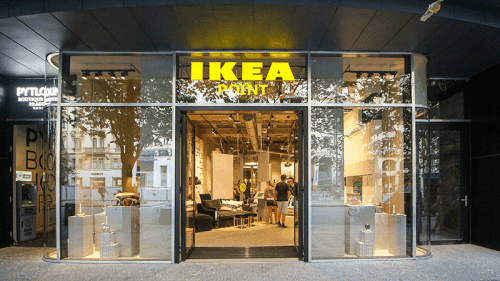While demand is strong in the Asia Pacific real estate industry, the supply of core product is thinner than ever, according to Emerging Trends in Real Estate® Asia Pacific 2017, a real estate forecast jointly published by ULI and PwC. The low transaction volumes in the first six months of 2016 come as owners opt to refinance properties at lower rates instead of selling them. In general, investors are reporting fewer overall transactions but bigger ticket sizes. Yields are falling; but looking forward, while most investors see potential for some further compression—mainly as a result of the sheer weight of new capital being pointed at the sector—the trend may be reaching its limit.
Emerging Trends in Real Estate® United States and Canada 2017 | Emerging Trends in Real Estates® Europe 2017
“Real estate markets across the Asia Pacific are being shaped by a number of external forces that are continuing to drive capital toward particular types of asset classes and geographies,” said Dr. Seek Ngee Huat, chairman, ULI Asia Pacific, and chairman, Global Logistic Properties. “On one hand, as bond rates sink ever lower, real estate becomes increasingly attractive as a means to deliver returns that fixed-income markets can no longer deliver, driving up prices of core assets and creating intense competition with more money chasing fewer assets. On the other, fund managers with a mandate to deliver a certain level of return are being forced into uncharted waters as they seek out yield.”
“This year’s Investment Prospects survey shows a strong shift away from last year’s favorites, which featured core markets in Japan and Australia. Instead, it favors emerging-market destinations, with two Indian cities topping a list which also includes Vietnam and the Philippines. It is also notable that several gateway cities are in the bottom half of the list, indicating their declining popularity,” said K.K. So, Asia Pacific real estate tax leader, PwC. “Although demand for core assets in gateway cities remains strong, buyers are struggling to source investable assets at acceptable prices that deliver higher returns. Increasingly, those returns are most evident in emerging-market destinations. Last year’s survey results showed a ‘flight to safety’ approach. This year’s results, with four emerging-market destinations as the top choices, reflect a very different mandate—a ‘quest for yield.’ ”
Other major survey findings include steep declines in the popularity of gateway cities (with the exception of Shanghai, which has held its own). In particular, Singapore—an investor favorite just a few years ago—has sunk to near the bottom of the rankings as it struggles with overcapacity, falling demand, and a slump in its residential sector. This overarching shift reflects the difficulty in sourcing core assets in an environment where owners have few other places to invest their capital if they sell, together with the growing urgency of investors’ quest for yield as returns are squeezed ever lower.
Emerging Trends, which is being released at a series of events across Asia over the next several weeks, provides an outlook on Asia Pacific real estate investment and development trends, real estate finance and capital markets, and trends by property sector and metropolitan area. It is based on opinions culled from surveys from and interviews with almost 700 internationally renowned real estate professionals, including investors, developers, property company representatives, lenders, brokers, and consultants.
The top five markets for investment and development in 2017 are as follows:
- Bangalore (first in investment and development). The big story for investors has long been the city’s role as India’s main hub for the business process outsourcing (BPO) and IT industries. There is huge demand for space as both domestic and international companies flock to open call-in and research-and-development centers.
- Mumbai (second in investment, third in development). Mumbai’s geography has prevented easy expansion of the city’s metropolitan area, which has made it both the most expensive city in India and the slowest growing. A major road and rail infrastructure program will allow for easier access to the center from outlying areas, with most construction scheduled for completion before 2019.
- Manila (third in investment, fourth in development). The Philippines continues to attract positive comments, with its vibrant economy led by a booming BPO market and strong remittances from overseas workers. Today, the fundamentals appear as strong as ever. Demand is resilient and vacancies remain low. Office capital values and rents continue to show good growth.
- Ho Chi Minh City (fourth in investment, second in development). Vietnam is one of the fastest-growing economies in Southeast Asia and is probably the most popular real estate investment destination. Capital comes from numerous sources, but in particular from Japan, Singapore, and Hong Kong.
- Shenzhen (fifth in investment, fifth in development). The major recent talking point for Shenzhen has been its residential sector, where prices soared more than 40 percent year-on-year in the first three quarters of 2016—the fastest in the world. On the commercial side, office rents have been on a steady upward trajectory for years and are now double their level in 2009.
Other findings from the report include the following:
- Core assets continue to be the favored asset class, although product is becoming increasingly hard to source. One way around this is for investors to assume development risk by pursuing “build-to-core” projects. Although these are not traditionally considered a core strategy, many core investors are now willing to adopt this approach, especially when it involves buyers such as insurance companies that are likely to be long-term holders of the end product.
- Investors with a mandate for higher-return strategies continue to migrate up the risk curve, both in terms of sectors—pursuing niche strategies such as sub-logistics facilities or data centers—and geographically, with emerging markets such as India drawing increasing attention.
- Investments in metro areas have become a popular theme given ongoing trends of urbanization, land shortages in city centers, and low returns from central business district projects. Cities across the Asia Pacific region, including Sydney, Shanghai, Mumbai, and Jakarta, are engaged in major transportation construction projects that link suburbs or satellite towns to city centers.
- In line with markets in the West, Asia is embracing the shared economy. The last 12 months have seen huge growth in the adoption of shared workspaces, either as stand-alone businesses that rent open-plan office facilities to individual or corporate users, or on a corporate basis, as large companies scrap conventional office layouts and embrace hot-desking and collaborative working environments. On the residential side, shared spaces are also becoming more prominent as rising prices continue to shrink apartment footprints.





